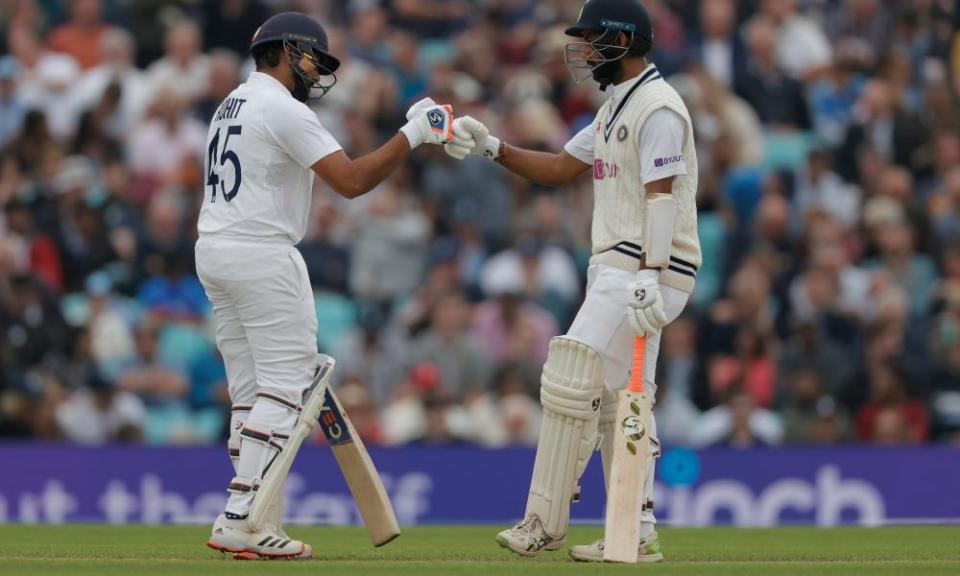Happy crowds drink in the Oval’s lovable old pub atmosphere
Three years ago, in one of its smarter moves, the Oval did away with disposable plastic beer cups and replaced them with reusable, stackable ones that you could keep all day and then return at the close of play for a £1 refund.
Apart from the manifold environmental advantages, encouraging spectators to keep their beer cups had the pleasing fringe benefit of allowing them – and everyone else – to keep a running tally of their consumption.
Related: India turn the tide in fourth Test as Rohit century frustrates England
Now, as play winds down for the evening, you can see punters carrying around their enormous stacks like trophies: some 10 or 15 cups high, a living sud-soaked monument to consumption and perseverance. “How was your day at the cricket, dear?” For the first time, this is a question with a knowable, measurable answer.
As India insouciantly stacked up the runs on a breezy and tepid third day, it was easy to ignore the many similarly impressive feats of accumulation taking place in the stands. It is one of Test cricket’s truisms that there are times when it is only really tangentially about the cricket.
With the greatest of respect to Cheteshwar Pujara and Ollie Robinson, a long disappearing afternoon when the run rate is comfortably below three an over is just such an occasion: a time to take an amble, to gather in the dimly lit concourses and queue for liquid refreshment and the disposal of it, to get gradually and gratifyingly drunk.
At this point, we should probably be clear about the sort of drunkenness we are talking about here. Like the game itself, cricket drunkenness comes in many different formats but somehow the original remains the best. There is a place for the rowdy, happy-hour chugging of Friday Blast nights, for the hedonistic, congas-and-sunstroke drinking associated with overseas tours.
But done right, and paced right, English Test match drunkenness remains the primary and most perfectly realised form of sporting drunkenness invented: a whole day of quiet, judgment-free guzzling with all four results – total bliss, existential crisis, uncontrollable giggling and sleep – possible.

Most importantly, Test match drinking exists largely independent of the game. In fact, the less happening the better: simply sip away and let the picture blur a little at the edges.
Seen through this hazy prism, even the most inert passages of play begin to take on a narcotic fascination. Is that a silly mid-on? Why do they call it a silly mid-on? Joe Root looks funny when he bowls. Did Pujara spend six minutes having his foot strapped or did I imagine it? A cricket field is awfully big, when you think about it. That man’s wearing two hats. It must be quite lonely being an umpire. I wonder what they think about. Whatever happened to Yusuf Pathan? Right, time for another.
One thing that has changed about Test match drinking is the variety. The craft beer revolution came late to cricket, which until a few years ago was still cleaving to its time-honoured menu of fizzy piss in a choice of two colours. Now, walk around an English Test ground and you are overwhelmed by the sheer range of booze: a dozen different kinds of beer, specialist gin, wine bars, cocktail kiosks serving something called a Lazy Negroni or for the pricier palate a bottle of Veuve Clicquot at £85 (not including £5 carafe charge).
Naturally, you encounter significant regional variations. Edgbaston, with its menacing concourses and unruly football-ish energy, probably overdoes it a little. The huge windswept temporary stand at Old Trafford is a magnificent place to drink, throw beachballs and generally lose all feeling in your toes and good luck getting a Lazy Negroni at Headingley.
Related: Rohit Sharma puts India in control against England: fourth Test, day three – as it happened
The Oval, by contrast, often has the feel of a lovable old pub, with its narrow passageways, weathered brick walls and dimly lit nooks where you will often find Shane Warne having a cheeky fag.
To an extent there is an element of gentrification to all this: the reimagining of the sporting venue as a sort of flat-pack entertainment village, a pop-up food and drink stall with some cricket attached. By the same token you sense a growing ambivalence towards alcohol within English cricket. We are told that one of the main aims of the Hundred was to pivot away from the boozy atmospheres of the Blast. We are told that English cricket needs to become more family-oriented, less lairy and blokeish.
There are elements of truth to all this. Any well-meaning attempt to diversify cricket’s audience should be welcomed but this brings us back to the discussion about different kinds of drunkenness. For every boorish vulgarian making loud jokes about Quinton de Kock there are probably 100 fans getting quite harmlessly tipsy: watching the cricket, not really watching the cricket, chatting, absorbing, simply being.
The essential truth is that cricket and drinking have always been inextricably, irresistibly intertwined: from John Arlott’s trusty glass of red to the dressing room tins to the cheeky pint placed just over the boundary at deep square-leg.
You don’t need to drink to enjoy cricket, but there are times when the two just feel perfect together. From the bars a magnificent roar heralds the dismissal of Rohit Sharma and the end of a long, patient stand. Meanwhile, cricket’s longest and most rewarding partnership of all carries on unbroken.

 Yahoo Sport
Yahoo Sport 





































